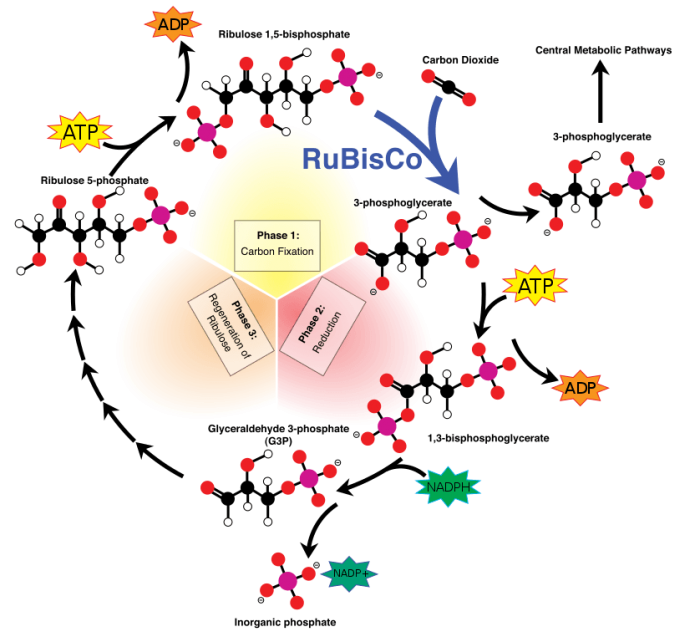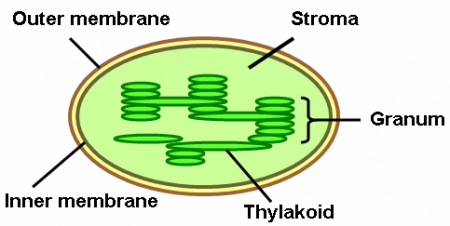
How do plants eat? They do not have mouths and they cannot forage or hunt, so how do they get their food? Unlike animals like humans, dogs, or cats who must get their food from external sources, plants are capable of creating their own supply of food from inorganic sources of carbon. Plants can take energy from the sun and use that energy to synthesize carbohydrates. The process by which plants convert solar energy into chemical energy is called photosynthesis. During photosynthesis, carbon dioxide and water are converted into carbohydrates and molecular oxygen. The carbohydrates become the fuel the plant uses to run its body and the oxygen is released into the atmosphere. In other words, photosynthesis is how plants are able to make their own food.
Photosynthesis is ecologically important for 2 major reasons: it is the ultimate source of organic material in every ecosystem because it creates organic material from inorganic carbon, and photosynthetic activity regulates the composition of Earth’s atmosphere by removing carbon dioxide and producing molecular oxygen.
Photosynthesis: Brief Overview

A simplified diagram of the process of photosynthesis. Credit: D. Mayer via WikiCommons CC BY-SA 3.0
Photosynthesis is a chemical reaction that uses light energy to facilitate the construction of simple and complex sugars from molecules of carbon dioxide and water. Strictly speaking, there are other kinds of photosynthesis that do not use carbon dioxide or water, however, most photosynthetic organisms use these two compounds. Photosynthesis that uses oxygen and water is called oxygenic photosynthesis.
The basic chemical reaction for oxygenic photosynthesis is:
CO2 + 2H2O + photons → [CH2O] + O2 + H2O
During photosynthesis, one molecule of carbon dioxide and 2 molecules of water are converted into molecular oxygen and some carbohydrate. Creating organic compounds from inorganic carbon is known more generally as “carbon fixation.” Carbon fixation can be considered the opposite of cellular respiration. Cellular respiration consists of the oxidation of carbohydrates into carbon dioxide while carbon fixation consists of the reduction of carbon dioxide to carbohydrates. Photosynthesis is thus a kind of carbon fixation that uses energy derived from light.
Plants are able to do photosynthesis in virtue of a special green pigment in their cells called chlorophyll. Molecules of chlorophyll absorb incoming sunlight and convert that sunlight into chemical energy. Chlorophyll absorbs all spectrums of visible light except green, so it is responsible for the green color of plants and algae.
Photosynthesis consists of 2 stages. First is the light-dependent reaction in which energy from light is captured to create energy dense ATP and NADPH. Second is the light-independent reaction in which the products from the first reaction are used to fix carbon.
Light-Dependent Reactions
The first stage of photosynthesis consists of the conversion of light energy into chemical energy in the form of ATP and NADPH. This portion of photosynthesis requires light energy to occur so it is called light-dependent.
First, incoming photons are absorbed by molecules of chlorophyll, which frees an electron from them. These free electrons are transferred from molecule to molecule, creating an electron transport chain that terminates in the reduction of NADP+ to NADPH. this movement of electrons also creates a proton gradient across the cellular membrane, the energy from which is used to create ATP. Chlorophyll molecules regain their electrons after a molecule of water is split in a process called photolysis, one of the products of which is molecular oxygen.
The overall chemical reaction for the light-dependent portion of photosynthesis is:
2 H2O + 2 NADP+ + 3 ADP + 3 Pi + light → 2 NADPH + 2 H+ + 3 ATP + O2
The end point of this reaction is the formation of ATP and NADH. The chemical energy contained in these two molecules is used in the next step of photosynthesis to construct carbohydrates.
Light-Independent Reactions
The second stage of photosynthesis involves the conversion of carbon dioxide into carbohydrates. This process is sometimes called the “Calvin cycle.” There are three major divisions of the Calvin cycle: fixation, reduction, and regeneration.

The Calvin cycle. Credit: M. Jones via WikiCommons CC BY SA-3.0
First, a molecule of carbon dioxide is captured by the enzyme ribulose-1,5-biphosphate (RuBP) which creates a 6-carbon structure. this 6-carbon molecule is split into 2 3-carbon molecules called phosphoglyceric acid (3-PGA). ATP and NADPH are used to turn the two 3-PGA molecules into two 3-carbon sugars called glyceraldehyde-3-phosphate (G3P). Lastly, a few of these G3P molecules condense to form larger 6-carbon sugars. Other molecules of G3P are used to regenerate to RuBP enzyme so that the process can begin anew.
Overall, the chemical reaction of the Calvin cycle is:
3CO2 + 6NADPH + 5H2O + 9ATP → glyceraldehyde-3-phosphate (G3P) + 2H+ + 6NADP+ + 9ADP + 8Pi (Pi = inorganic phosphate)
It takes 6 full turns of the Calvin cycle to produce one molecule of glucose, totaling out to 6 CO2, 18 ATP, and 12 NADPH per every molecule of glucose. These reactions do not require light to occur, so they are called light-independent. However, these reactions do in fact only take place during the daytime as the reaction is much more efficient with a steady supply of light.
Where Does Photosynthesis Occur?
Photosynthesis in plants takes place in their cells in specialized structures called chloroplasts. Chloroplasts are organelles in plant cells consisting of 3 membrane system, the inner, outer, and thylakoid membranes. Both inner and outer membranes keep foreign pathogens out and allow the transport of required nutrients into the chloroplasts. Filling the space between these membranes is a high-protein fluid substance called stroma.

The inner structure of a chloroplast. Credit: WikiCommons CC0 1.0
Suspended throughout the stroma in a chloroplast are a collection of membranous sacks called thylakoids. Embedded directly in these thylakoid membranes are the light-absorbing chlorophyll pigments. Thylakoids have a tendency to stack on top of one another, creating cellular complexes called grana, which are the main sites of photosynthesis in plant cells. Carbon dioxide enters the plant through tiny pores on the leaves called stoma. Photosynthetic reactions occur, and the oxygen product is released into the atmosphere from the stoma. These reactions take place inside the stroma of the chloroplasts.
Ecological Importance Of Photosynthesis
All living organisms require a supply of food. Most organisms, like humans, are heterotrophs meaning that they get their organic materials from external sources. Heterotrophs cannot create their own source of food so they have to go out and eat other organic material. Autotrophs, on the other hand, can fix their own carbon compounds from inorganic sources. This fact makes autotrophs play a crucial role in every ecosystem, as they are the ultimate source of the organic material consumed by all other animals. All organic matter eaten by heterotrophs can trace its origin back to the photosynthetic activity of autotrophs. Even in the case of one heterotroph eating another heterotroph, the energy consumed originally had to come from some autotroph the prey ate in the past. Without the photosynthetic activity of plants and other autotrophs, there would not be a steady supply of organic molecules needed to drive more complex life.
Photosynthesis also plays a crucial role in the removal of carbon dioxide from the atmosphere and the production of the oxygen we breathe. Plants remove carbon dioxide from the atmosphere to create food. This makes them a valuable asset for controlling carbon emissions. Photosynthesis also creates oxygen as one of its byproducts. This oxygen is released into the air and becomes the oxygen we breathe. Without plants and other photosynthetic organisms, we would not have a steady supply of oxygen to breathe.
Photosynthetic Bacteria
Plants are the most common kinds of photosynthetic organism, but they are not the only kinds. There are many photosynthetic bacteria and some of the first organisms to exist were photosynthetic bacteria.
One particularly well known photosynthetic prokaryotic is cyanaobacteria. Cyanobacteria are a phylum of bacteria that gain their energy through photosynthesis. Cyanobacteria are the only oxygenic photosynthetic bacteria. For billions of years, cyanobacteria pumped oxygen into early Earth’s atmosphere, turning it into the oxygen-rich one that we have today. The release of oxygen from photosynthetic cyanobacteria over 600 million years ago laid the foundation for the formation of complex multicellular life because the presence of oxygen in the atmosphere allowed the evolution of high-energy oxygen-based metabolic reactions.
There are a handful of theories that claim that photosynthetic bacteria and chloroplasts in plants share an evolutionary relationship. According to the prominent endosymbiotic theory, chloroplasts evolved via the endosymbiosis of prokaryotic bacteria into larger eukaryotic cells. Chloroplasts share many similarities with photosynthetic bacteria, like proteins, ribosomes, and circular chromosomes. Chloroplasts even have their own DNA that is distinct from the nuclear DNA of the cell and this DNA resembles that found in cyanobacteria. Thus, it is thought that chloroplasts are photosynthetic bacteria that adapted to live inside plant cells.
Some bacteria perform photosynthesis but do not produce molecular oxygen. Anoxygenic photosynthesis occurs due to the presence of hydrogen sulfide as a reducer instead of water. Anoxygenic photosynthesis results in the formation of elemental sulfur instead of molecular oxygen. Sulfidogenic bacteria absorb sunlight using pigments structurally similar to chloroplasts in plants. Such bacteria are an important part of the sulfur cycle, the geobiochemical process that is responsible for organic sulfurs found in living things.








